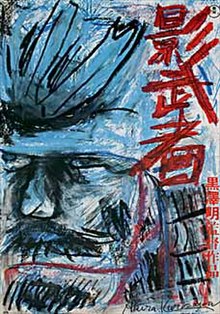Kagemusha
| Kagemusha | |
|---|---|

Kurosawa's own artwork
|
|
| Directed by | Akira Kurosawa |
| Produced by |
|
| Written by |
|
| Starring | Tatsuya Nakadai |
| Music by | Shin’ichirō Ikebe |
| Cinematography | Takao Saitō |
| Edited by | Akira Kurosawa (uncredited) |
|
Production
company |
|
| Distributed by |
|
|
Release date
|
|
|
Running time
|
|
| Country |
|
| Language | Japanese |
| Budget | |
| Box office | ¥3,057,990,000 or $26,000,000 (Japan) |
Kagemusha (影武者 Shadow Warrior?) is a 1980 film by Akira Kurosawa. In Japanese, kagemusha is a term used to denote a political decoy. It is set in the Sengoku period of Japanese history and tells the story of a lower-class criminal who is taught to impersonate a dying daimyō to dissuade opposing lords from attacking the newly vulnerable clan. The daimyō is based on Takeda Shingen, and the film ends with the climactic 1575 Battle of Nagashino.
In Japan's Sengoku period, Takeda Shingen, daimyō of the Takeda clan, meets with his brother Nobukado, and an unnamed thief whom the latter met by chance and spared from crucifixion due to the thief's uncanny resemblance to Shingen. The brothers then agree that he would prove useful as a double, and they decide to use the thief as a kagemusha.
Later, Shingen's army has besieged a castle of Tokugawa Ieyasu. When Shingen visits the battlefield to hear a mysterious nightly flute player, he is shot by a sniper. Mortally wounded, he orders his generals to keep his death a secret for three years. Shingen later dies while being carried over a mountain pass, with only a small group of witnesses. Meanwhile, Shingen's rivals, Oda Nobunaga, Tokugawa Ieyasu, and Uesugi Kenshin are each shown contemplating about Shingen's supposed passing.
Nobukado presents the thief to Shingen's generals (many of the renowned Twenty-Four Generals of Takeda Shingen), proposing to have this kagemusha impersonate Shingen full-time. At first, even the thief is unaware of Shingen's death, until he tries to break into a huge jar, believing it to contain treasure, and instead finds Shingen's preserved corpse. After this act, the generals decide they cannot trust the thief and set him free.
...
Wikipedia
